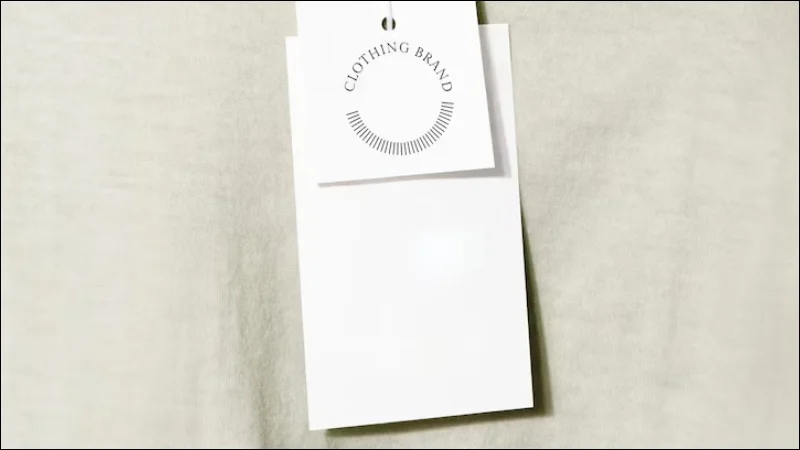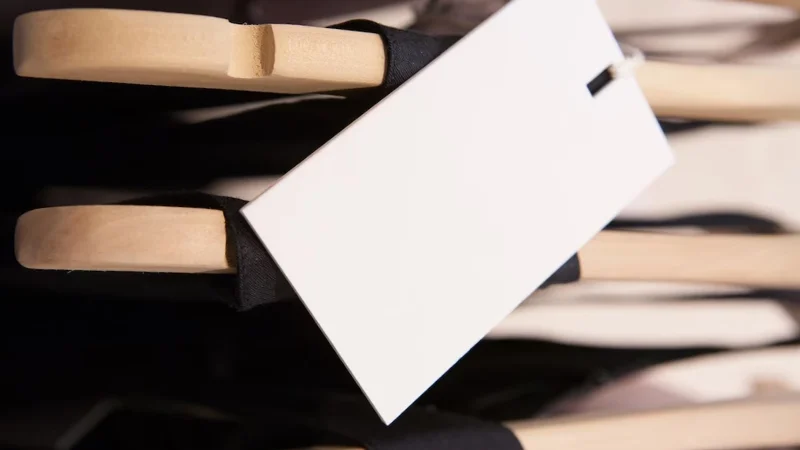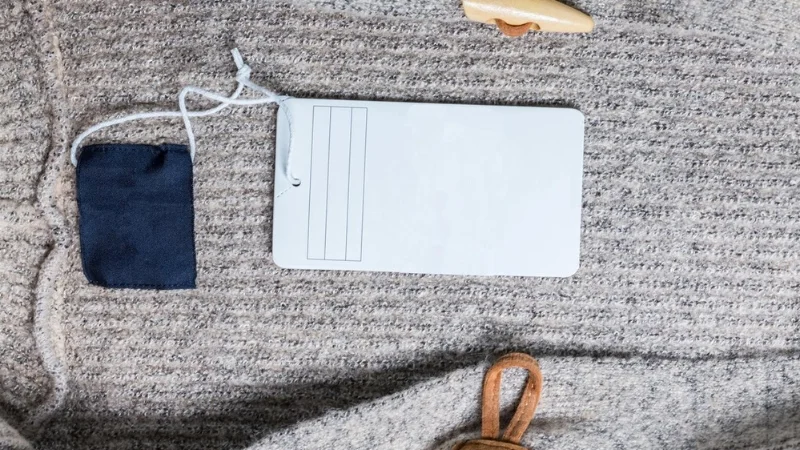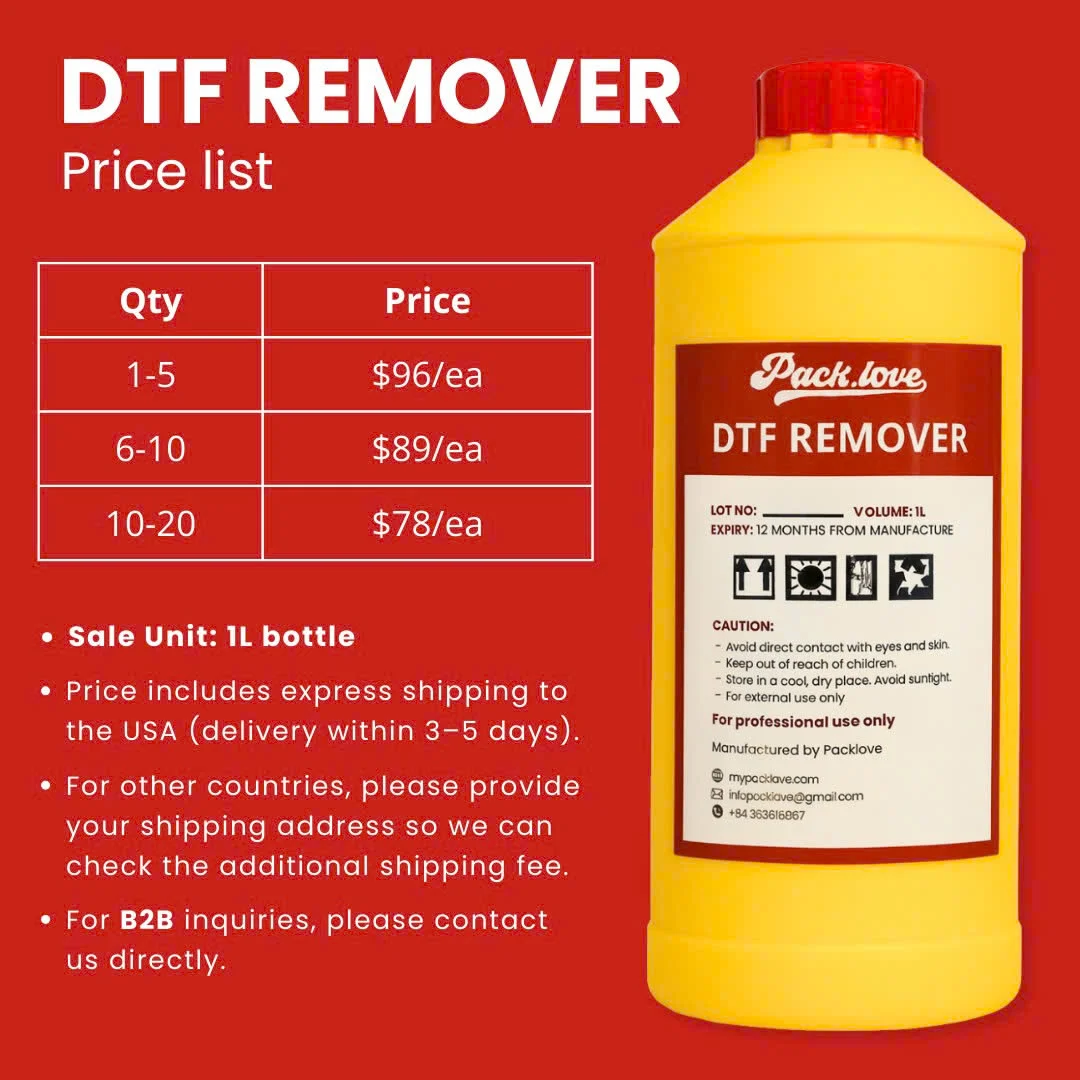Cardstock Guide: Quality Apparel Hang Tags
As an apparel business owner, navigating the world of materials for your branding elements, especially hang tags, can feel overwhelming. Terms like GSM, Points, and Cover Weight often create confusion when all you want is a tag with the right thickness, stiffness, and material durability. Cardstock is the foundational material for creating tags that convey quality and professionalism. Getting the paper choice right significantly impacts how customers perceive your apparel brand, as the tag is a tangible touchpoint reflecting your standards. A flimsy tag can undermine even the finest garment, while a substantial one enhances its value.
This guide cuts through the jargon surrounding cardstock specifications. You’ll gain clarity on critical factors like paper weight and thickness, understand different types and finishes, and learn how these choices affect the durability and professional feel of your final hang tags. Ultimately, this knowledge will empower you to select the perfect cardstock, ensuring your tags effectively represent your brand’s quality and withstand handling from production to the customer’s hands. Let’s explore these aspects.
1. Unpacking Cardstock: More Than Just Thick Paper
1.1 Defining Cardstock: Key Characteristics
At its core, cardstock is a type of paper engineered to be significantly thicker, heavier (possessing a higher Basis Weight or grammage), and more rigid than standard printing or writing paper. This enhanced thickness and stiffness are its defining features, providing durability and a substantial feel. While various materials can be used, traditional cardstock is typically manufactured from wood fibers, often a blend of hardwood and softwood pulps, contributing to its robust material composition. Think of it as paper’s sturdier cousin, designed for applications where longevity and presence are important.

1.2 Why Cardstock Matters for Your Apparel Brand Image
The quality of your hang tags speaks volumes about your apparel brand before the customer even tries on the garment. A tag made from flimsy paper can create a negative first impression, subtly suggesting lower perceived quality, regardless of the garment’s actual craftsmanship.
Cardstock, with its inherent durability, ensures your tags withstand the rigors of transport, stocking, and customer handling, maintaining a crisp, professional feel. This resilience is crucial; a tag that bends or tears easily detracts from the overall brand image. Choosing a sturdy cardstock demonstrates attention to detail and reinforces the quality standards associated with your brand, enhancing the customer impression from the outset.
1.3 Cardstock vs. Regular Printing Paper: A Clear Distinction
The difference between cardstock and regular printing paper boils down primarily to thickness and rigidity. Regular paper, like the kind used in office printers (often a lighter weight), is flexible and relatively thin. Cardstock, being a type of heavy paper, is noticeably thicker and resists bending much more effectively.
Imagine the difference between a lightweight handout flyer (regular paper) and a sturdy postcard designed to survive the mail (cardstock) – that contrast in substantiality and stiffness captures the fundamental distinction. This difference is critical when selecting materials for items like hang tags that need to hold their shape.
2. Decoding Cardstock Measurements: Making Sense of the Numbers for Tags
2.1 Understanding Paper Weight: Grams per Square Meter (GSM) Explained Simply
One common way to measure paper weight is using Grams per Square Meter (GSM). This is a straightforward international standard: it simply represents the actual weight of a single sheet of paper measuring one meter by one meter. The key takeaway is direct: a higher GSM number indicates a heavier paper. This higher weight generally corresponds to greater paper density and often, increased thickness and stiffness, contributing to the overall cardstock weight and feel.
For reference, standard office paper typically falls between 80-100 GSM, light cardstock might range from 180-250 GSM, while heavier, more substantial cardstocks usually start around 270 GSM and go up from there.
2.2 Understanding Paper Weight: Basis Weight (lbs) Explained
In the United States, paper weight is frequently expressed using the Basis Weight system, measured in pounds (lbs). This system can be confusing because the weight number itself (e.g., 80lb) doesn’t tell the whole story.
The Basis Weight refers to the weight of a standard stack (usually 500 sheets) of paper cut to its traditional “basis size,” and crucially, this basis size differs between paper categories. For hang tags, the most relevant category is Cover Stock, which has a different basis size than Text Weight paper (used for brochures or book pages).
This difference means that 80lb Cover Stock is significantly thicker and heavier than 80lb Text Weight paper. Therefore, when evaluating paper using lbs, always confirm whether the weight refers to Cover or Text stock. Common Cover weights suitable for tags include 80lb, 100lb, 120lb, and 130lb Cover, representing a good range for various tag requirements under this paper weight standard.
2.3 Understanding Thickness: Points (pt) and Caliper
Perhaps the most intuitive thickness measurement for cardstock is the Point (pt) system. One point (1pt) is equal to exactly one-thousandth of an inch (0.001″). The term Caliper is often used interchangeably with points to describe the physical thickness of a sheet. This measurement directly relates to the stiffness and substantial feel of the hang tags.
A higher point value means a thicker, more rigid tag. Common thicknesses for apparel tags range from about 10pt for lighter options, 12pt to 14pt for standard tags, up to 16pt, 18pt, or even higher for premium, very sturdy tags. Focusing on the Point (unit of thickness) value gives a clear indication of how robust the tag will feel.
2.4 Practical Guide: What Weights & Thicknesses Work Best for Hang Tags?
Choosing the right cardstock weight and thickness involves balancing durability, desired premium feel, budget, and the garment itself. Here’s a practical guide connecting the measurements to common hang tag specifications:
| Tag Type / Feel | Approx. Weight Range | Approx. Thickness Range | Considerations |
|---|---|---|---|
| Lightweight / Budget | ~216 GSM / 80lb Cover | ~10pt | More flexible, suitable for delicate items |
| Standard / Versatile | ~270 GSM / 100lb Cover | ~12pt – 14pt | Good balance of quality, stiffness, and cost |
| Premium / Heavy Duty | ~350+ GSM / 130lb+ Cover | ~16pt+ | Very sturdy, best for luxury or heavy garments |
2.5 Common Cardstock Weights for Apparel Tags
80lb Cover / ~216 GSM:
Uses and limitations: This lightweight option feels noticeably more substantial than regular paper but remains quite flexible. It’s a suitable budget option for apparel tags on lighter garments like t-shirts or blouses, or for internal tags not requiring high perceived value. However, its limitations include lower perceived quality compared to heavier stocks and a greater tendency to bend or crease during handling.

100lb Cover / ~270 GSM:
A popular, versatile choice considered a standard in the industry, 100lb Cover offers a great balance. It provides good stiffness and a professional feel, making it a popular choice for a wide range of apparel hang tags. This versatile weight is durable enough for most retail environments without the higher cost of premium stocks, representing a solid middle ground for quality and value.
130lb+ Cover / ~350+ GSM:
For premium durability and luxury weights like 130lb Cover (or even heavier) are the way to go. This heavyweight cardstock is very sturdy and rigid, approaching the feel of thin paperboard. It’s ideal for high-end brands, heavy garments like denim or outerwear, or any situation where maximum tag resilience and a substantial impression are desired. The increased stiffness conveys quality, though it comes at a higher material cost.
3. Exploring Cardstock Types & Finishes for Standout Tags
3.1 Surface Finish Options: Matte Finish Paper, Glossy Finish, Silk/Satin
The surface finish of your cardstock significantly impacts the look and feel of your hang tags. Here’s a breakdown of common options:
Matte Finish Paper: This finish has no shine or surface coating, providing a flat, non-reflective look.
- Pros: Offers a classic, understated appearance. Excellent writability for adding notes or sizes. Reduces glare. Can hide minor imperfections well.
- Cons: Colors may appear less vibrant than on coated stocks. Can be more susceptible to absorbing oils or moisture if uncoated.
- Feel for Tags: Smooth but natural, often perceived as elegant or earthy depending on the paper itself.
Glossy Finish: Features a high-shine, reflective surface coating.
- Pros: Makes colors pop and appear very vibrant. Provides some scuff resistance due to the coating. Creates a high-impact look.
- Cons: Highly reflective, can show fingerprints and smudges easily. Difficult for writability. Scratches can be very noticeable.
- Feel for Tags: Very smooth and slick. Often associated with modern or bold branding.
Silk/Satin Finish: These offer a low-level sheen, sitting between Matte and Glossy. They have a smooth surface coating but without high reflectivity.
- Pros: Enhances print quality and color vibrancy without harsh glare. Offers good scuff resistance. Difficult to write on but less prone to showing fingerprints than full gloss. Often feels premium.
- Cons: Less writable than matte. Sheen level can vary slightly between suppliers.
- Feel for Tags: Very smooth, luxurious, and refined. A popular choice for a sophisticated look.
3.2 Textured Cardstock: Linen, Felt, Laid, Vellum
Beyond smooth surfaces, textured cardstock introduces a tactile appeal that can make your tags stand out. Common textures include:
- Linen Finish: Features a subtle crosshatch pattern mimicking linen fabric. Adds an elegant, classic feel.
- Felt Finish: Offers a softer, slightly uneven texture, reminiscent of felt material. Conveys warmth and a handcrafted quality.
- Laid Finish: Characterized by fine parallel lines, simulating the look of handcrafted paper. Suggests tradition and formality.
- Vellum: While often referring to a finish, traditional Vellum is a translucent paper type sometimes used as an overlay on tags for a layered effect. (Note: Modern “vellum finish” cardstock offers a smooth, frosted look, distinct from traditional translucent vellum).
Using textures adds a sensory dimension, enhancing brand aesthetics – perhaps luxury (Linen), natural (Felt), or traditional (Laid). These unique characteristics can elevate the perceived value. However, be mindful that very deep textures can slightly affect the crispness of extremely fine print or small text due to the uneven paper texture.
3.3 Specialty Cardstocks: Kraft, Recycled, Coated
Certain cardstocks align particularly well with specific brand aesthetics or functional needs:
- Kraft Cardstock: Instantly recognizable by its natural brown color and often slightly fibrous appearance. Perfect for rustic, eco-conscious, handmade, or industrial aesthetics. Its earthy look strongly communicates certain brand values.
- Recycled Cardstock: Made partly or wholly from recovered paper fibers (often specified with a Post-Consumer Waste Percentage). Choosing recycled stock clearly signals a commitment to sustainability. While appearance varies (some show subtle flecks, others look identical to virgin fiber stock), it’s a powerful message for environmentally conscious brands.
- Coated Cardstock: Features a surface coating (C1S = Coated One Side, C2S = Coated Two Sides) applied during manufacturing. This coating (which can be matte, silk, or gloss) creates a smoother, less porous surface, leading to sharper, more vibrant printing quality and enhanced durability against moisture and scuffing. Essential when print precision and resilience are priorities. The surface coating significantly changes how ink sits on the paper.
Selecting these specialty stocks is about deliberately choosing a material that reinforces your brand story or meets specific performance requirements like enhanced printing quality or durability.
3.4 Choosing a Finish: Impact on Print Appearance, Writability, and Scuff Resistance
The decision on cardstock finish involves balancing several factors:
- Print appearance: Coated Cardstock (Glossy, Silk, some Mattes) generally yields sharper details and more vibrant colors as ink sits on the surface. Uncoated Cardstock (like standard Matte) absorbs more ink, resulting in a softer look, which can be desirable for certain aesthetics.
- Writability: Uncoated Matte finishes are typically the best for writing with pens or markers. Most coated finishes resist ink.
- Scuff resistance: Coated finishes generally offer better protection against scuffs, moisture, and handling marks compared to Uncoated Cardstock. Glossy shows fingerprints easily, while Silk and Matte coatings can be more forgiving.
4. Cardstock vs. Cover Stock: Is There a Real Difference for Your Tags?
4.1 Defining Cover Stock: How the Term is Used in Printing Materials
In the world of printing materials, particularly within the US market, the terms Cardstock and Cover Stock are frequently used almost interchangeably. Both refer to heavyweight paper suitable for applications requiring more durability and stiffness than standard Text Weight paper – applications like book covers, business cards, postcards, and importantly, hang tags.
While there isn’t a rigidly defined technical distinction universally applied, ‘Cover Stock’ generally implies paper stocks falling within the heavier weight ranges appropriate for covers, distinguishing them clearly from lighter ‘Text’ stocks used for interior pages. For practical purposes when sourcing materials, don’t get overly concerned about the specific label; focus instead on the paper’s actual properties.
4.2 Practical Implications for Apparel Brands: Does the Label Matter More Than the Specs?
For apparel brands selecting materials for hang tags, the specific name used by a supplier – whether they call it Cardstock or Cover Stock – is far less important than the material’s actual specifications. The critical factors determining suitability are the measurable properties: the weight (GSM or lb Cover), the point thickness (pt), and the finish (e.g., Matte, Silk, Glossy, Textured).
When ordering or requesting quotes, always specify these details. Focusing on the specs ensures you get the material performance you need, regardless of the terminology used. Effective cardstock selection relies on understanding these properties, not just the product name.

4.3 Focusing on Properties: Weight, Thickness, and Finish are the critical factors for selection
Ultimately, your selection process should center on the tangible properties of the paper. Key decision criteria include:
- Weight: Measured in GSM or Basis Weight (specifically lb Cover for tags), indicating the paper’s density and heft.
- Thickness: Measured in Points (pt) or Caliper, directly relating to the physical thickness and resulting stiffness.
- Finish: The surface treatment (e.g., Matte, Gloss, Silk, Textured, Coated/Uncoated), affecting appearance, feel, printability, and material durability.
These are the factors that dictate how the tag performs and looks. To provide context, Cardstock/Cover Stock sits below Paperboard in terms of rigidity and thickness. Paperboard is significantly thicker and stiffer, typically used for structural packaging like boxes, rather than flexible items like tags. Understanding this hierarchy helps position cardstock selection correctly – choosing a robust paper, but one still suitable for tag applications.
5. Selecting the Right Cardstock for Your Clothing Line: Expert Tips
5.1 Key Factors: Garment Type, Brand Style, Budget, Durability Needs, Printing Method Compatibility
Making the optimal cardstock selection for your apparel branding involves weighing several practical considerations. Here’s a checklist drawing on expert tips:
- Garment type: The item itself influences the choice. Heavy garments like denim jeans or outerwear can support, and often benefit from, a thicker, more substantial tag. Conversely, delicate fabrics like silk or chiffon require careful consideration; a very heavy tag might pucker the fabric or feel disproportionate.
- Brand style: Your brand’s positioning is crucial. A luxury brand will likely lean towards premium, thicker stocks, perhaps with unique finishes or textures, to convey exclusivity. A casual or fast-fashion brand might prioritize a balance of quality and cost-effectiveness, opting for versatile mid-weight options.
- Budget: Material costs vary significantly. Heavier weights, specialty finishes (like textures or heavy coatings), and eco-friendly options often come at a higher price point. Determine your acceptable cost per tag early in the process.
- Durability needs: Consider the tag’s journey. Will it endure significant handling in a busy retail environment or potentially rough shipping conditions? If so, prioritize thicker, potentially coated stocks for better resilience against bending, tearing, and scuffing.
- Printing method compatibility: Your chosen print design and method matter. Highly detailed graphics or processes like foil stamping may require smoother, often coated surfaces for best results. Some textured stocks might not be suitable for very fine print. Ensure your chosen cardstock works well with your intended printing technique.
5.2 Recommendations for Different Apparel Categories
While flexibility exists, here are some common starting points for matching cardstock to apparel categories:
- T-shirts & basics: For everyday items, a 100lb Cover Matte or Silk finish (~270 GSM, ~12-14pt) provides a professional feel and adequate durability without unnecessary expense. This versatile weight offers a good balance.
- Denim & outerwear: These robust garments pair well with heavier cardstock. Consider 130lb Cover or thicker (~350+ GSM, ~16pt+) in finishes like Matte, Kraft, or even a subtle texture. The added weight complements the garment’s sturdiness.
- Luxury & boutique items: To convey premium quality, opt for substantial stocks. Thick options like 130lb+ Cover (~350+ GSM) with elegant finishes (Silk, premium Matte, subtle Textures like Linen) work well. Double-thick tags can also create a distinct luxury impression.
- Childrenswear: Durability is often key. A sturdy 100lb or 120lb Cover (~270-325 GSM, ~12-15pt), possibly with a protective coating (Silk or Matte coated), can withstand more handling while still being suitable for smaller garments.
5.3 Thinking About Print Design: How Intricate Graphics or Solid Colors Interact with Cardstock
Your print design interacts differently depending on the cardstock surface:
- Smooth/Coated Cardstock: Surfaces like Gloss, Silk, or smooth Matte coated stocks provide the best canvas for intricate graphics, fine text, and photographic images. The ink sits crisply on the surface coating, allowing for sharp detail and vibrant, consistent solid colors. This enhances printing quality for designs demanding precision.
- Uncoated Cardstock/Matte: These stocks tend to absorb ink more readily. This creates a softer, more muted look which can be desirable for certain aesthetics (e.g., vintage, natural). However, large areas of solid color might appear slightly less saturated or uniform compared to coated stocks due to ink absorption.
- Textured Cardstock: Textures like Linen or Felt add tactile interest but can interfere with print clarity. Very fine lines or small text might break up slightly over the texture’s peaks and valleys. Best suited for simpler designs where the texture itself is a primary feature.
Consider how the cardstock’s surface properties will render your specific artwork to achieve the intended visual result.
5.4 Considering Eco-Friendly Options: Benefits of Recycled Content and Sustainable Sourcing
Choosing eco-friendly options for your cardstock can be a powerful aspect of your brand image. Key considerations include:
- Recycled Cardstock: Look for options containing Post-Consumer Waste (PCW). Specifying a high PCW percentage demonstrates a strong commitment to reducing waste. Some recycled stocks have visible flecks, adding character, while others offer a smooth finish comparable to virgin fiber papers.
- Sustainable Sourcing: Certifications like FSC Certified indicate that the paper pulp comes from responsibly managed forests.
6. Beyond Tags: Other Uses for Cardstock in Apparel Branding
6.1 Business Cards
Cardstock is the industry standard for business cards, providing the necessary durability and professional feel. Common business card standards often utilize thicknesses ranging from 14pt to 16pt pt or higher for a substantial impression.
6.2 Lookbook Covers and Inserts
For creating impactful marketing materials, cardstock offers the rigidity needed for durable lookbook covers or high-quality inserts that enhance the premium appearance.
6.3 Packaging Inserts, Thank You Cards, Warranty Cards
Within your product packaging materials, using cardstock for packaging inserts, thank you cards, or warranty cards adds a touch of quality and reinforces branding.
6.4 Small Point-of-Sale Displays or Signage
The inherent stiffness and rigidity of cardstock make it suitable for small Point-of-Sale displays or countertop signage that needs to stand independently.
7. Related Questions
7.1 Can I print effectively on thick cardstock with a standard office printer?
Attempting to print cardstock, especially thick cardstock, on a standard office printer often leads to challenges. Most home or office printers have a maximum paper weight limit (check your printer’s specifications), typically struggling with anything much heavier than 80lb Cover / ~216 GSM. Feeding issues like jamming are common, and ink adhesion or print quality may suffer on very thick or coated stocks. For consistent, high-quality results on heavier cardstocks appropriate for tags, utilizing professional printing services is generally recommended.
While thicker cardstock certainly enhances durability and conveys a premium feel, it’s not automatically the best choice for all clothing hang tags. Very thick tags cost more, add bulk, and might physically overwhelm delicate garments like silk blouses.
The ideal cardstock weight involves balancing the desired brand perception, the garment type, handling requirements, and budget. Sometimes, a well-chosen medium-weight cardstock offers the most appropriate combination of quality and practicality.
The cardstock finish plays a significant role in scuff resistance for hang tags. A Glossy finish, while vibrant, tends to show fingerprints and scuffs quite readily. Matte finishes, particularly Uncoated Cardstock, can sometimes hide minor scuffs better but may be more susceptible to absorbing oils or dirt.
Coated Cardstock (whether Gloss, Silk, or specific Matte coatings) generally offers the best surface protection against handling marks and moisture. Textured surfaces can also help camouflage minor imperfections.
There isn’t one universal standard size for apparel hang tags, as the ideal hang tag dimensions depend heavily on branding requirements, the amount of information displayed, the scale of the garment, and the attachment method.
However, common rectangular sizes often seen include dimensions like 2″ x 3.5″ (similar to a business card), 1.5″ x 3″, or square formats like 2″ x 2″. It’s advisable to consider the tag’s visual proportions relative to the clothing item.
Read more:
Selecting the right cardstock is a fundamental step towards achieving quality branding for your apparel line. As explored, understanding the nuances of weight, thickness, finish, and type empowers you to choose materials that not only look professional but also offer the necessary durability for hang tags.
A well-chosen tag enhances the professional feel and contributes positively to your overall brand presentation. Think of this material choice not as an expense, but as an investment in how customers perceive your products.
Effective cardstock selection ensures your tags reflect the quality of your garments and withstand the journey to your customer. For expert help navigating the options and selecting the perfect cardstock tailored to your brand’s unique needs and aesthetic, visit Packlove for personalized advice and high-quality solutions.























